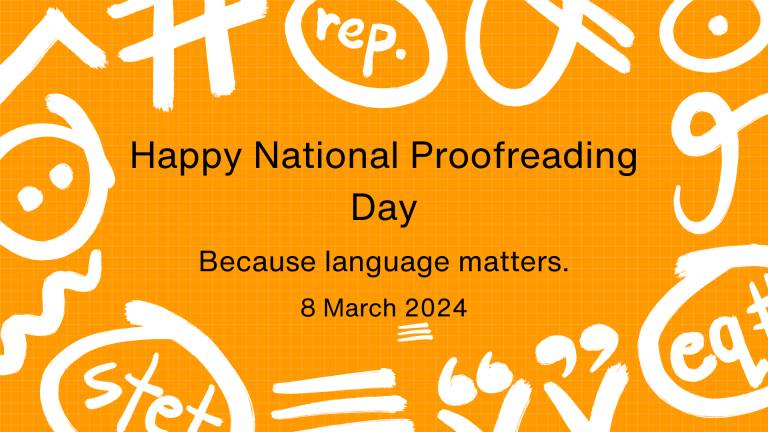We celebrate National Proofreading Day on 8th March every year. It promotes awareness about the importance of proofreading, sharing tips for effective proofreading and encouraging individuals to take the time to review and edit their written work. It also highlights that proofreading plays a crucial role in ensuring the accuracy and professionalism of written content.
In 2012, Judy Beaver created National Proofreading Day in memory of her mother, who cared about language correctness. Beaver thought creating the day on her mother’s birthday would be a perfect way to remember her mother and help people take more time to proofread their work.

What is proofreading?
National Proofreading Day is a perfect occasion to learn more about proofreading. Proofreading is the process of carefully reviewing a written document to identify and correct spelling, grammar, punctuation, syntax and formatting errors. The goal of proofreading is to ensure that the text is accurate, clear and free of mistakes before it is published, submitted or shared with an audience.

Proofreading is a critical step in the writing and editing process, and it goes beyond simply checking for typos. It involves a meticulous examination of the entire document to catch errors in language usage, sentence structure, and overall coherence. Here are some key aspects of proofreading:
- Spelling and grammar: Correcting misspelled words and ensuring proper grammar usage.
- Punctuation: Checking for accurate placement and usage of commas, periods, semicolons, colons, quotation marks, etc.
- Syntax and sentence structure: Ensuring that sentences are clear, logical and well-constructed.
- Consistency: Verifying consistent formatting, style and language use throughout the document.
- Formatting: Checking for proper layout, font, spacing and indentation as per the required guidelines.
- Capitalisation: Confirming correct capitalisation of words, especially in titles and headings.
- Abbreviations and acronyms: Ensuring that abbreviations and acronyms are used consistently and appropriately.
- Numbers: Verifying the accuracy of numerical data and ensuring consistent use of numbers.
- Cross-referencing: Checking references, citations and cross-references for accuracy and completeness.
How to proofread your own text?
National Proofreading Day may be the perfect motivation to learn how to improve your proofreading skills. Proofreading your own text can be challenging because you are likely familiar with the content, making it easier to overlook errors. However, with some strategies and a systematic approach, you can improve the effectiveness of your self-proofreading. Here are some tips:
- Take a break: Allow some time to pass between writing and proofreading. This break helps you approach your text with a fresh perspective, making it easier to spot errors.
- Use proofreading tools: Leverage spelling and grammar checkers in word processing software. While these tools are not foolproof, they can catch common errors and provide suggestions.
- Read aloud: Reading your text aloud can help you identify awkward phrasing, grammatical errors and typos. Hearing the words can bring attention to mistakes that your eyes might overlook.
- Read backwards: Review your text sentence by sentence or paragraph by paragraph backwards. This disrupts the flow of the text, making it easier to focus on individual words and spot errors.
- Print your document: Reading a printed version of your text can help you see it in a different format and may make errors more noticeable.
- Check formatting: Ensure that your document follows the required formatting guidelines. Check headings, fonts, spacing and indentation.
- Create a proofreading checklist: Develop a checklist of common errors you tend to make. Refer to this list during the proofreading process to ensure a thorough review.
- Be mindful of homophones: Pay special attention to homophones (words that sound the same but have different meanings and spellings). Spell-check tools may not catch these errors.
What are the advantages of working with a professional proofreader?
Proofreading is typically one of the final steps in the writing and editing process, coming after the more substantive editing stages. While spell-checking tools and grammar-checking software can be helpful, they may not catch all errors, and human proofreaders can provide a more comprehensive review.
Working with a professional proofreader can offer several advantages, contributing to the overall quality and effectiveness of your written content. Here are some key benefits:
- Error-free content: Professional proofreaders are trained to meticulously review and correct spelling, grammar, punctuation and other language-related errors. This ensures that your document is free from embarrassing mistakes that could impact your credibility.
- Adherence to style guides: If your document needs to adhere to a specific style guide (such as APA, MLA, Chicago, etc.), a professional proofreader will ensure that your content complies with the guidelines, including proper citation formats and other stylistic conventions.
- Fresh perspective: Since professional proofreaders are not intimately involved in the content creation process, they bring a fresh perspective to your document. This can be especially valuable in identifying areas that might be unclear to readers or may need additional clarification.
- Time savings: Hiring a professional proofreader allows you to focus on your core tasks and responsibilities, saving you time and effort. It ensures that your document is polished and error-free without requiring you to spend excessive time on proofreading.
- Professionalism: A well-proofread document reflects professionalism and attention to detail. This is particularly important in business and academic contexts where the quality of written communication can significantly impact your reputation.
- Reduced bias: A professional proofreader can provide an unbiased review of your content. This impartial perspective is valuable in catching errors and improving the overall quality of your writing.
What is the difference between proofreading and editing?
Proofreading and editing are distinct stages in the writing and revision process, each serving a specific purpose. Here are the key differences between proofreading and editing services (such as line, substantive or developmental editing):
Editing
- Focus: Editing primarily deals with the overall structure, organisation and content of a document.
- Purpose: The goal of editing is to improve the clarity, coherence and effectiveness of the writing. Editors may suggest changes to the order of information, the choice of words, or the overall flow of the text.
- Content issues: Editors address larger issues, such as the relevance of content, the strength of arguments, the development of ideas and the overall structure of the document.
- Language use: While editing, attention is given to language use, but the primary concern is ensuring that the content is strong, logical and well-presented.
- Involvement: Editing typically involves more collaboration between the writer and the editor. The editor may provide feedback, suggestions and revisions for the author to consider.
Proofreading
- Focus: Proofreading is the final stage and focuses on the surface-level details of a document.
- Purpose: The primary goal of proofreading is to catch and correct errors in grammar, spelling, punctuation and formatting.
- Content issues: Proofreaders do not address major content issues or make significant changes to the structure or organisation of the document. Their main concern is the correctness of the language.
- Language use: Proofreaders pay close attention to language use, ensuring that sentences are grammatically correct, words are spelt accurately and punctuation is used appropriately.
- Involvement: Proofreading is often a more independent task. Proofreaders work to ensure that the document is free from errors and is ready for publication or submission.
In summary, editing focuses on the overall quality and structure of the content, addressing larger issues related to clarity and coherence. Proofreading, on the other hand, is concerned with the final polish, ensuring that the document is error-free and adheres to language conventions. Both stages are crucial for producing a high-quality and professional piece of writing, and they complement each other in the writing and revision process.
Final thoughts
In conclusion, National Proofreading Day serves as a reminder of the significance of proofreading in creating accurate and professional written content. Celebrating National Proofreading Day can foster a greater appreciation for the art of proofreading and encourage individuals to strive for excellence in their written communication. By following the tips and strategies mentioned in this text, you can improve your proofreading skills and ensure that your work is free from errors. However, for those who require a more thorough and reliable review, working with a professional proofreader can offer numerous advantages, including adherence to style guides and error-free content.
If your text requires proofreading, contact me for a free sample edit of your text (and remember to use my early bird discount). I am an experienced editor and proofreader working with non-fiction, academic and business texts.

